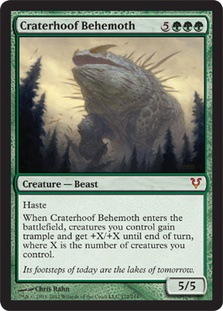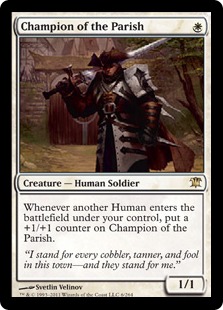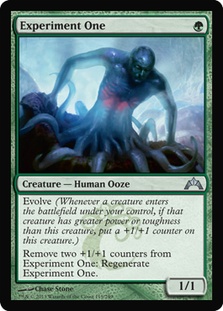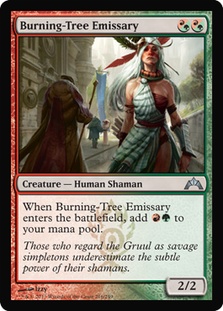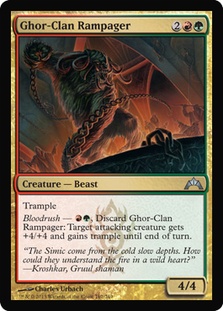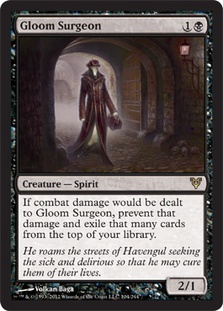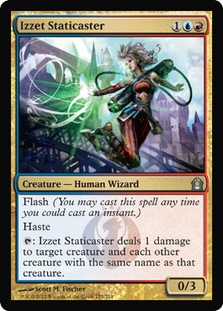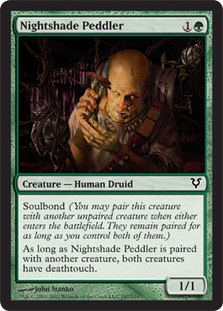Hello! The first thing I want to do today is to congratulate my compatriot Dmitriy Butakov for his outstanding performance at the Magic Online Championship! It was a well-deserved and long-awaited result. Even Rich Hagon knows a few Russian words now, and I hope there will be reasons to learn more in the near future.
Standard is the most important topic right now—there are no excuses like “Modern PTQ season is in progress”—so let’s take a look at the format’s metagame and try to figure out some weaknesses to exploit. Spoilers for the new set, Dragon’s Maze, are already in progress, but we all have a full month and many important tournaments to play until it is released—including PTQs, WMCQs, SCG Opens, and the first of four SCG Invitationals of 2013. The recent set of big tournaments completely changed Standard, pushing a relatively forgotten deck over the top, proving there’s still an opportunity to take format by the storm.
I obviously chose the most accessible data source to get a picture of the Standard metagame: Magic Online Daily Event results. The advantages and disadvantages of this data source have been widely discussed, so I’m not going to repeat them; I just wanted significant statistics to have a basis for further musings. Five Daily Events with a grand total of 290 decks were analyzed (which says a lot about Daily Event size). About twenty different decks were found, with ten of them having ten or more appearances (which says a lot about the format’s diversity and, combined with DE’s size, about attractiveness). However, the best deck casually filled 22%, reminding us of the good old times with Faeries and Jund. Here’s the data:
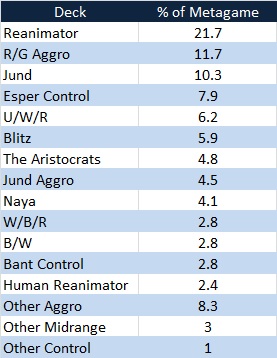
Reanimator made 63 appearances and is clearly the deck to beat and the best deck in Standard. Could you imagine reading these words three weeks ago? Can you imagine similar words about another deck in three weeks? It’s unlikely but certainly possible.
The key points of Standard’s current state are the dominance of Reanimator and the high amount of aggressive decks that are aiming to beat it. I’d say that Craterhoof Behemoth should be on the decline right now, but Butakov’s win will probably drive it even higher, at least for some time. So right now beating Reanimator is the main goal, while beating aggro decks is the second one, and I expect them to switch sometime in the near future.
One deck’s domination always leads to two things: the rise of the deck’s bad matchups and its adaptation to these matches and to the mirror match. Reanimator decks have started maindecking removal to increase their chances against fast aggro decks (and I strictly prefer Orzhov Charm to Abrupt Decay and Sever the Bloodline in this case); some players even transition into sort of a G/W/B midrange deck with less Reanimation (if at all) and value creatures like Trostani, Selesnya’s Voice, Loxodon Smiter, and Sigarda, Host of Herons.
The deck is still weak to fast aggro, as they sometimes just have unbeatable draws no matter what the Reanimator pilot has, but when we speak about average and below-average draws, Reanimator is clearly in contention and is still at the top due to the inconsistency of fast aggro decks.
Reanimator’s mirror match is a very strange beast, and there is not much you can do. Your opponent may have or may not have graveyard hate, so you may or may not want to sideboard into midrange—but you can never be sure. If nobody wins fast (due to Craterhoof Behemoth, for example), the game usually turns into “who will cast the last Angel of Serenity?” mode, so the most attractive ideas for the mirror are Somberwald Sage (bad in aggro matches) and Slaughter Games (which is generally weak due to mana issues).
Mike Krasnitski won Grand Prix Verona two weeks ago, and his exact 75 is still great (though I’d sideboard one or two Sepulchral Primordial to upgrade the mirror match). Dmitriy Butakov’s winning deck is very similar in its simplicity. Note maindeck Orzhov Charm, the interesting choice of Borderland Ranger to simulate both Mulch and Centaur Healer, and the sideboarded Elderscale Wurm, who might be even better than Griselbrand against aggressive decks.
Creatures (25)
- 2 Borderland Ranger
- 3 Arbor Elf
- 4 Avacyn's Pilgrim
- 4 Restoration Angel
- 2 Craterhoof Behemoth
- 4 Thragtusk
- 3 Angel of Serenity
- 3 Centaur Healer
Lands (23)
Spells (12)

If you choose this deck, you must understand that your choice results in a target on your forehead, a gambling-style mirror match, and a weakness against a third of the metagame. Nevertheless, the deck’s prospects look bright, as aggro’s rise will be suppressed by midrange decks (which are generally good matchups) and even a lot of hate is not fearsome. Moreover, G/W/B Reanimator is relatively easy to play, so I can definitely recommend it as a good choice—just make sure you know how to play the mirror match. Note that three of the five Reanimator players at the MOCS chose to pack Somberwald Sage in their decks—that’s much more than the general metagame presence of Sage and very wise in a mirror-heavy metagame.
Places two through four in the metagame chart are occupied by the most popular representatives of aggro, midrange, and control. An interesting point is that all deck types have multiple representatives, which is especially important in the case of aggro. There are many great aggressive creatures, but their most powerful combinations require multicolored mana bases and negatively influence consistency. The data clearly shows that speed is more important than card quality; The Aristocrats is the only heavier aggro deck that survived in significant quantities despite the good results recently demonstrated by various Zombie decks. Heavy presence of G/R Aggro has also proven a local fluctuation, though I believe green-based aggro will rise when there’s less Reanimator around.
The balance between speed and consistency tips in favor of consistency—the very impressive Naya Blitz and Jund Aggro are two times less popular than R/G Aggro, which should be noted despite budget concerns. Three crucial aggressive creatures are Champion of the Parish, Experiment One, and Burning-Tree Emissary. Jund Aggro plays two of them, and Naya Blitz has all three; Mono-Red Aggro has only one, but Boros Reckoner and Hellrider help to mitigate that downside.
R/G Aggro has evolved from Tomoharu Saito’s all-in creation with only eighteen lands into builds that are a little heavier, not sharing Blitz’s direction of development. Also note that 23-land Mono-Red Aggro with Thundermaw Hellkite is extinct (with along with Saito Naya): a turn 5 Hellkite is just too slow for this format, even with the strong presence of Lingering Souls. A list recently played by well-known grinder bolov0 is a great example of a successful compromise between speed, power, and consistency.
Creatures (31)
- 4 Stromkirk Noble
- 4 Hellrider
- 4 Lightning Mauler
- 4 Flinthoof Boar
- 4 Rakdos Cackler
- 4 Burning-Tree Emissary
- 3 Ghor-Clan Rampager
- 4 Boros Reckoner
Lands (20)
Spells (9)
Sideboard

This list is simple and powerful, has a good mana curve, and is able to beat Reanimator through Lingering Souls and Thragtusk (especially post-board). Bolov0’s list contains three Ghor-Clan Rampagers, which may be too much for the mana base. The problem with two-colored aggressive decks is that there are only eight sources of the second color aside from the generally unacceptable Guildgates. However, Ghor-Clan Rampager and Rancor are good enough to justify two Temple Gardens as Forests, also providing mana for Boros Reckoner.
Aside from that, Mono-Red Aggro is still good ol’ Mono-Red. There is correctly no graveyard hate in the deck because its main weapons against Reanimator are speed and Skullcrack; the most important tasks to solve with the sideboard are dealing with other aggressive decks (additional removal) and Jund (Volcanic Strength and Domri Rade). If everything is done right, R/G Aggro is a very solid contender, able to beat both Reanimator and other aggressive decks.
Midrange Jund is a strange beast right now; the deck’s popularity has decreased despite the rise of its best matchups. The reasons why are relatively bad matchups against Reanimator (where the best late-game weapon—Rakdos’s Return—is useless) and Assemble the Legion (which allows midrange decks in other colors be nearly as powerful and improves the control matchup, which is a traditional weak point of Jund). However, I mostly dislike midrange Naya due to its lack of flexibility. Turn 3 Assemble the Legion is great, but sometimes you’re just dead on board at that point.
So the most interesting “other” midrange deck is W/B/R. The deck appeared on Magic Online a relatively long time ago and is still under the radar despite its impressive potential. The deck trades Thragtusk and Huntmaster of the Fells for Boros Reckoner, Aurelia, the Warleader, and Lingering Souls, combining many powerful cards of the format. Let’s take a look at Oscar Jones’ list from the Magic Online Championship.
Creatures (13)
- 2 Olivia Voldaren
- 2 Falkenrath Aristocrat
- 1 Angel of Serenity
- 2 Aurelia, the Warleader
- 2 Obzedat, Ghost Council
- 4 Boros Reckoner
Planeswalkers (2)
Lands (26)
Spells (19)

The deck includes Faithless Looting, Liliana of the Veil, Unburial Rites, and an amazing set of powerful creatures. Essentially, it’s similar to G/W/B Reanimator—so much value and almost no fear of graveyard hate. In contrast to Reanimator, this deck has an impressive set of cheap removal, improving its aggressive matchups. Oscar also decided to put Gloom Surgeon into the sideboard (which was correct for his tournament), but most pilots play Surgeon maindeck as a great way to stop early aggression (which is correct for high-attendance tournaments).
By the way, Gloom Surgeon is also a legitimate sideboard option for Reanimator; it’s worse than Lotleth Troll due to having a drawback instead of an advantage, but Lotleth Troll requires mana for regeneration while Gloom Surgeon allows using all the resources to establish board position.
Another interesting thing to note about midrange decks in current Standard is how well Izzet Staticaster is positioned right now. Aggressive decks with many x/1 creatures are on the rise, and the best deck plays seven mana dorks and is vulnerable without them, so Izzet Staticaster Blinked by Restoration Angel deals with nearly half of the format. Nevertheless, Izzet Staticaster still only sees play as a one- or two-of in the sideboard of U/W/R. Look at the very interesting and innovative RUG Flash from Jeff Hoogland:
Creatures (15)
Lands (25)
Spells (20)

This is the perfect deck for maindeck Izzet Staticaster, and there is not one in his 75! By the way, the deck is very attractive aside from that and from the full four copies of Yeva, Nature’s Herald. I’d play Thundermaw Hellkite here and incorporate some Izzet Staticasters to improve removal spells—any one of them becomes dramatically better in conjunction with an additional one point of damage.
However, the best use of Izzet Staticaster is to pair her with Nightshade Peddler. This deck made the Top 8 of a Grand Prix not so long ago, but now it’s clearly forgotten. There were obviously good reasons for that—the Jund and U/W/R matchups are far from good. However, both decks are on the decline right now, while fast aggro is on the rise, and the potentially rising Somberwald Sage is the best opponent for Nightshade Peddler deck, making Peddle to the Metal look like a very good choice for the upcoming weeks. Since we last saw it, this four-colored creation got a much better mana base and possibly Domri Rade as an additional multipurpose card that can find combo pieces and deal with opposing creatures, upgrading our chances in the long game.
Creatures (23)
- 3 Olivia Voldaren
- 4 Huntmaster of the Fells
- 4 Nightshade Peddler
- 4 Thragtusk
- 4 Izzet Staticaster
- 4 Deathrite Shaman
Planeswalkers (2)
Lands (25)
Spells (10)

There’s nothing revolutionary about the list—it just seems to be in the right place at the right time. I’d note that our mana dork is much better than Jund’s, especially as he may realistically produce mana outside of the Reanimator matchup. Another notable card is Appetite for Brains, which is good at stopping astonishing Reanimator draws (and is very useful in Reanimator mirrors, disallowing the chaining of Angel of Serenity). The rest of the deck is obvious, though the four-colored mana base requires additional work. I also tried more complicated versions like the GP-winning Human Reanimator with Chronic Flooding and the Staticaster-Peddler combo or more Domri Rade and one or two Ogre Slumlord, but this simple list looks better than the others do.
Good luck to everyone playing; let’s peddle to metal!

